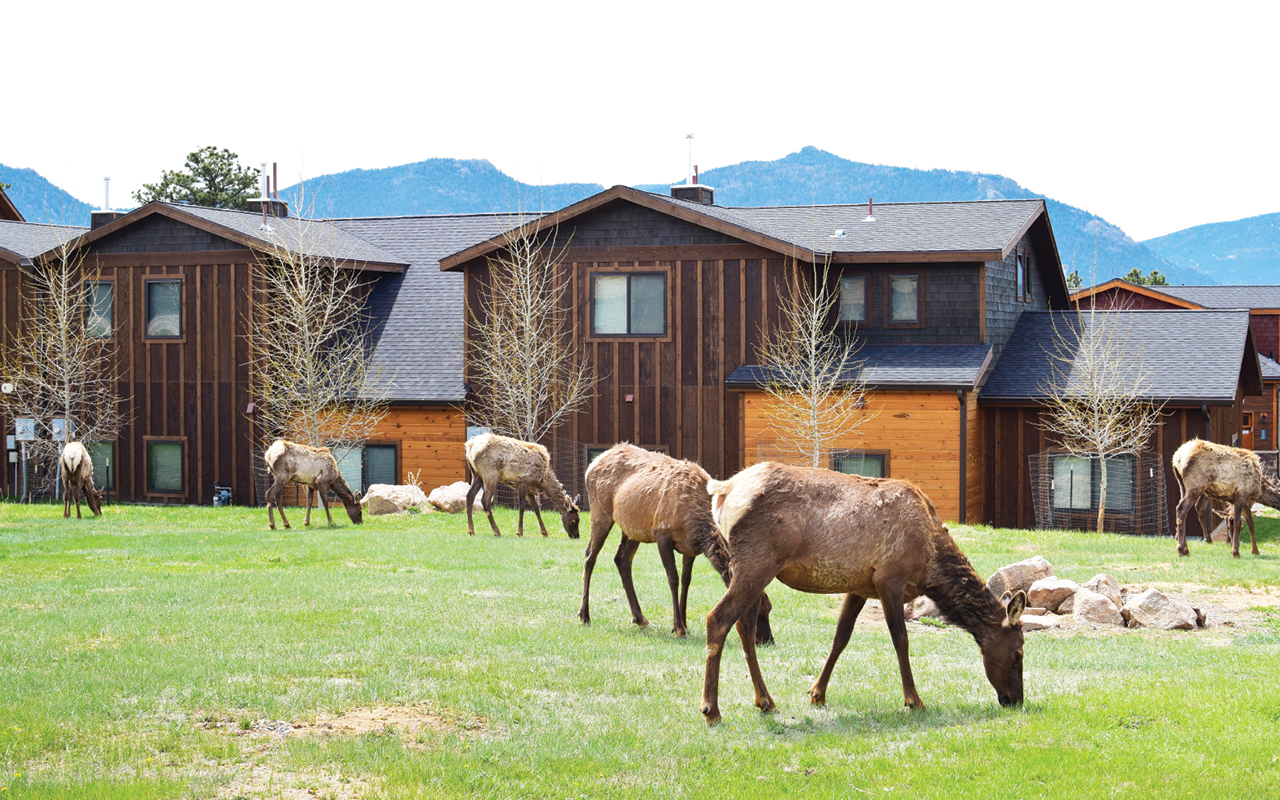Rocky Mountain National Park is indeed more than incredible alpine views … but, wow, those views are stunning!
The Rocky Mountains stretch for 200 miles along the Continental Divide of the United States, and Rocky Mountain National Park is just a mere 415 square miles of some of the world’s highest terrain. “Majestic” can’t even begin to describe the park’s alpine lakes and forested valleys which rise to Longs Peak, at 14,259 feet the highest point in the park. Known as “Rocky” to locals, Rocky Mountain National Park is one of the highest-in-elevation national parks in the country. Weather permitting, it’s open year-round and is the third most visited National Park in the country — definitely a must for RVers who enjoy mind-blowing scenery and abundant wildlife.
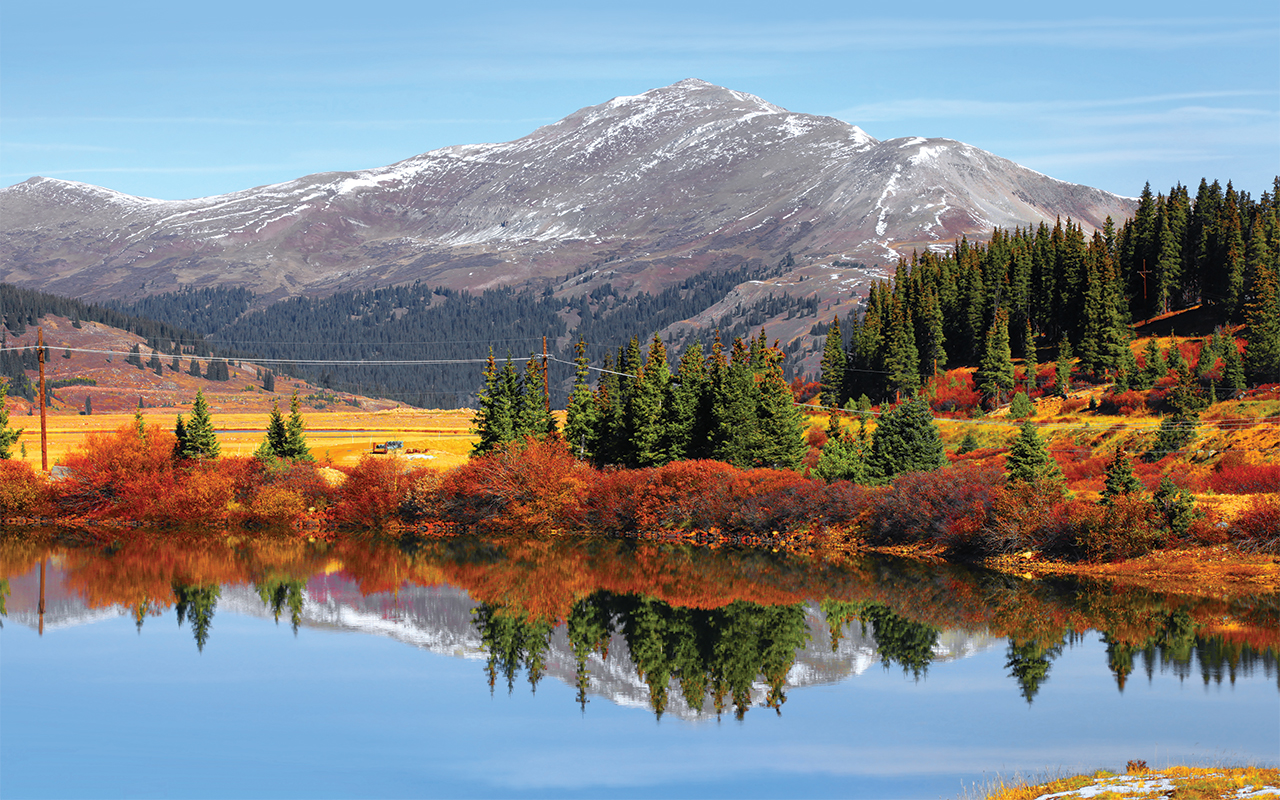
About two hours southwest of Rocky Mountain National Park, Buffehr Lake blazes with fall-foliage reflections.
The park is bisected by Trail Ridge Road, which climbs to 12,183 feet and is the highest paved through-road in the United States. It climbs and winds its way east to west (and vice versa) through the park, traveling through aspen and ponderosa pine forests, which give way to subalpine forests of fir and spruce and finally culminating in alpine tundra.
We visited Rocky Mountain National Park in September and opted to stay in Estes Park, aka “Colorado’s Original Playground.” This authentic mountain town has a long and colorful history of providing hospitality to vacationers from around the world. We arrived in the midst of the annual Longs Peak Scottish-Irish Highland Festival, which attracts clans from all over the world. Highland dancing, a strongman competition, pipe bands and even light armor jousting and caber-throwing were all taking place. Men in kilts were everywhere!
It is possible to camp in the park, although it’s not conducive to large motorhomes. There are five campgrounds within the park, and four are open to RVs. Moraine Park Campground is open all year and can accommodate RVs up to 40 feet long. The others are closed during winter months. Glacier Basin has capacity for rigs up to 35 feet and Aspen Glen and Timber Creek campgrounds are limited to RVs no longer than 30 feet. None of the park’s campgrounds offer RV hookups. Reservations are necessary, particularly during the busy summer months.
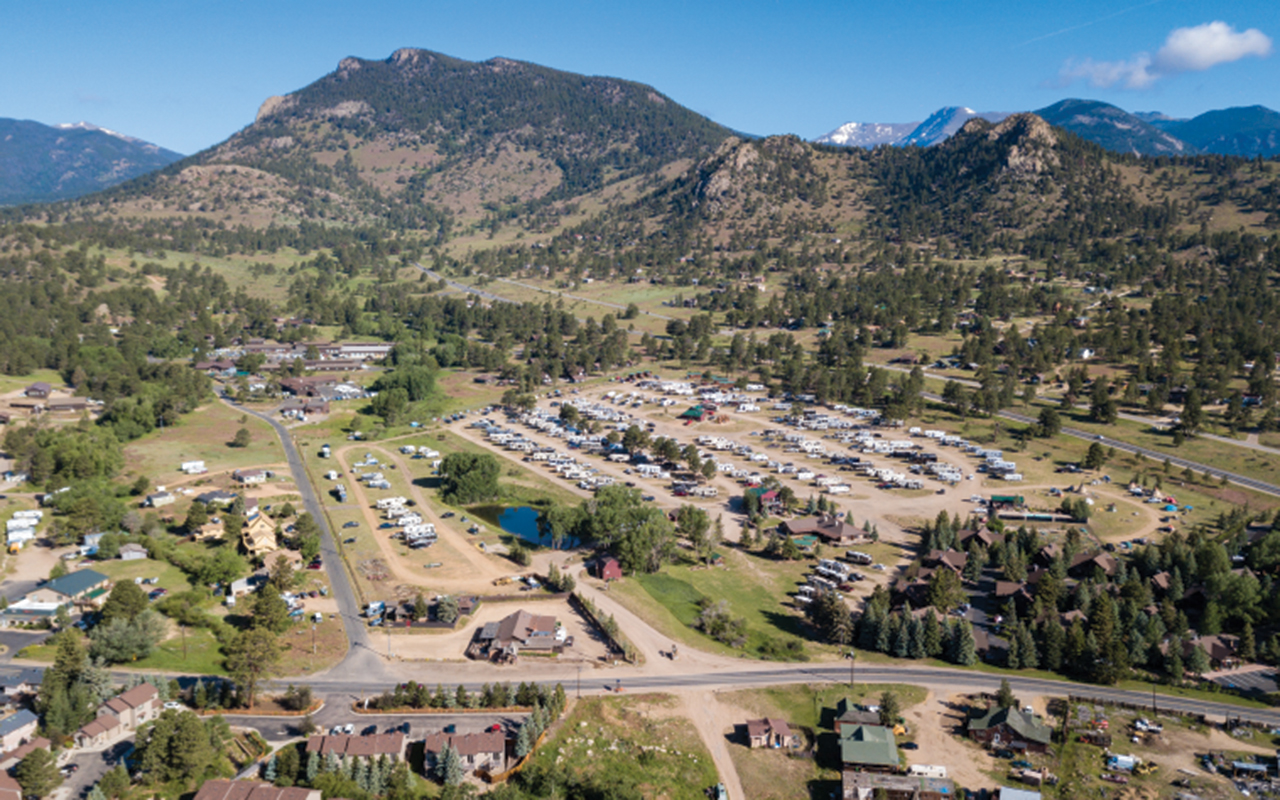
here are many private campgrounds in Estes Park, and Estes Transit offers free rides into town to enjoy the many activities there.
There are several private campgrounds in Estes Park and the surrounding areas offering all the amenities. We stayed at Spruce Lake RV Resort, a comfortable campground adjacent to the Big Thompson River. Estes Transit offers visitors and residents free bus transportation around town, encouraging day visitors to park at their transportation center and ride the bus during their stay. The town is charming, with many shops, restaurants and brew pubs. While my husband played golf at the city’s 100-year-old golf course, I spent time browsing the shops and riding the bus around town.
We spent most of a day driving Trail Ridge Road, logging about 48 miles from Estes Park to Grand Lake on the west side. At 11,500 feet, we reached the tree line, where the evergreen forests give way to the alpine tundra. It’s cold and windy — usually about 20 degrees cooler than down below. From the comfort of our car, we could see amazing views — north to Wyoming and south toward “14ers” — at 14,000 feet, the highest peaks in the Rocky Mountains. Wildlife and alpine plants are plentiful. Bighorn sheep roam the area and there are more than 200 species of native blooming alpine plants hugging the cold craggy ground.
Unlike its showy and popular big brother, Old Fall River Road is Rocky’s “other” road. It opened in 1920 and was the park’s first automobile route to the high country. It’s mostly gravel and one-way, uphill, peppered with switchbacks, following a Native American hunting route from years ago. With a 15-mph speed limit, it’s a much more intimate journey than Trail Ridge, which it joins at Fall River Pass near the park’s Alpine Visitor Center. Obviously, Old Fall River Road is not a road for motorhome travel; passenger cars only, so bring your dinghy vehicle. We did see a few smaller Class C motorhomes on Trail Ridge Road, but it also is not suitable for larger rigs. Keep in mind there are no guard rails!
Despite the high altitude, we managed to hike several trails within the park, as well as some in Estes Park. Rocky’s 107 hiking trails range from less than 1 mile to 39 miles in length, so there’s really something for everyone, no matter what your physical condition.
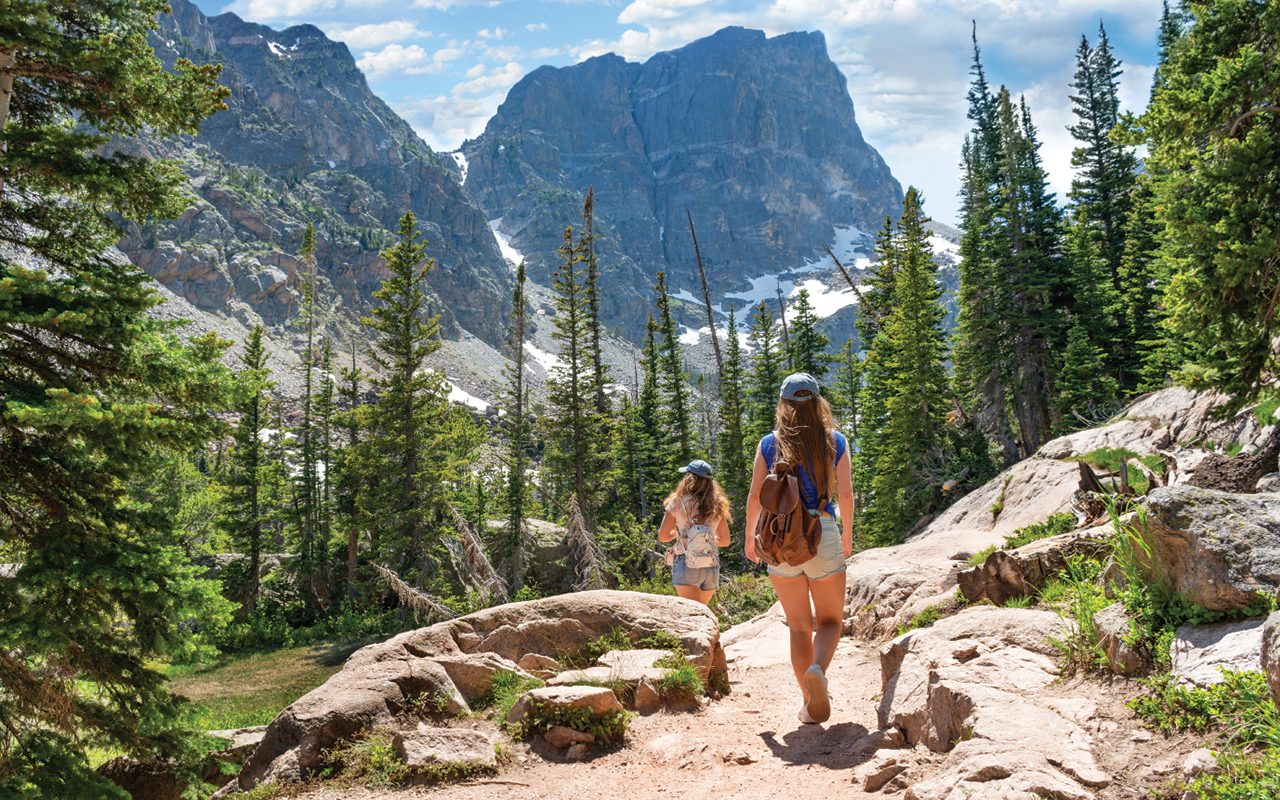
Rocky’s 100-plus hiking trails range from less than a mile to nearly 40 miles in length, making it a great spot for all ages to get out and enjoy the breathtaking views.
It’s believed man arrived in this area about 11,000 years ago, searching and hunting for food. Later, the Ute Indians and other tribes would come during the summer months, hunting, fishing and gathering food to last through the winter. The region was acquired by the United States government through the 1803 Louisiana Purchase, but because it was so craggy and rugged most explorers and fur trappers did not bother settling there. That all changed when the Pikes Peak gold rush in 1859 brought miners and speculators to the area hoping to make it rich. They established small and probably rowdy settlements and homesteads on the land. Although the winters were harsh, the abundant water and wildlife proved to be main attractions not just to settlers but eventually also to tourists.
By 1900, Theodore Roosevelt was leading a national conservation and preservation movement which further attracted visitors to the area. And in 1909, Enos Mills, a local naturalist, nature guide and lodge owner, championed efforts which led to the creation of the nation’s 10th national park. President Woodrow Wilson signed the Rocky Mountain National Park Act in 1915.
During the 1930s’ Depression, President Franklin Roosevelt created the Civilian Conservation Corps (CCC) to put people to work. In Rocky Mountain National Park, CCC crews built roads, trails and buildings. They put out fires, planted wildflowers and trees, and worked with the Park Service to build Trail Ridge Road. By the time World War II ended, families were looking for outdoor vacations which they could reach in their newly purchased automobiles. With a paved two-lane road running right through the park, Rocky was the perfect destination. By 2018, the park had 4.5 million visitors each year.
The most famous landmark in town is the Stanley Hotel, where time indeed slips away.

The Stanley Hotel opened its doors in 1909. Today, the hotel offers fine-dining opportunities, tours and even “spirited” rooms.
Freelan Oscar Stanley, an east coast inventor, came to Estes Park in 1903 suffering from tuberculosis. He flourished in the sunshine and clean mountain air and decided to return every summer. The small town did not offer much stimulation or entertainment for he and his wife during their stays, so they decided to build a beautiful grand hotel. The Stanley Hotel opened in 1909 and the first guests arrived in stylish Stanley-designed steam cars, one of which stands in front of the hotel to this day. Guests were amazed that in the rustic mountain wilderness there stood a hotel with electric lights, telephones, en suite bathrooms, uniformed servants — certainly up to the standards of a luxurious hotel in the East. The hotel also brought Estes Park into the 20th century, and with the hotel’s influence, by 1917 the town was an official municipality providing water and power to its residents.
During its heyday, the Stanley hosted many famous guests including “The Unsinkable Molly Brown,” Theodore Roosevelt, John Philip Sousa and the Emperor and Empress of Japan. Photos of Hollywood stars line the walls of the hotel’s lobby and restaurant. During the ’70s, the Stanley’s splendor had somewhat faded and it was rumored to close. However, author Stephen King visited for one night and was inspired to write his first hardcover bestseller, The Shining, which was later made into a movie starring Jack Nicholson.
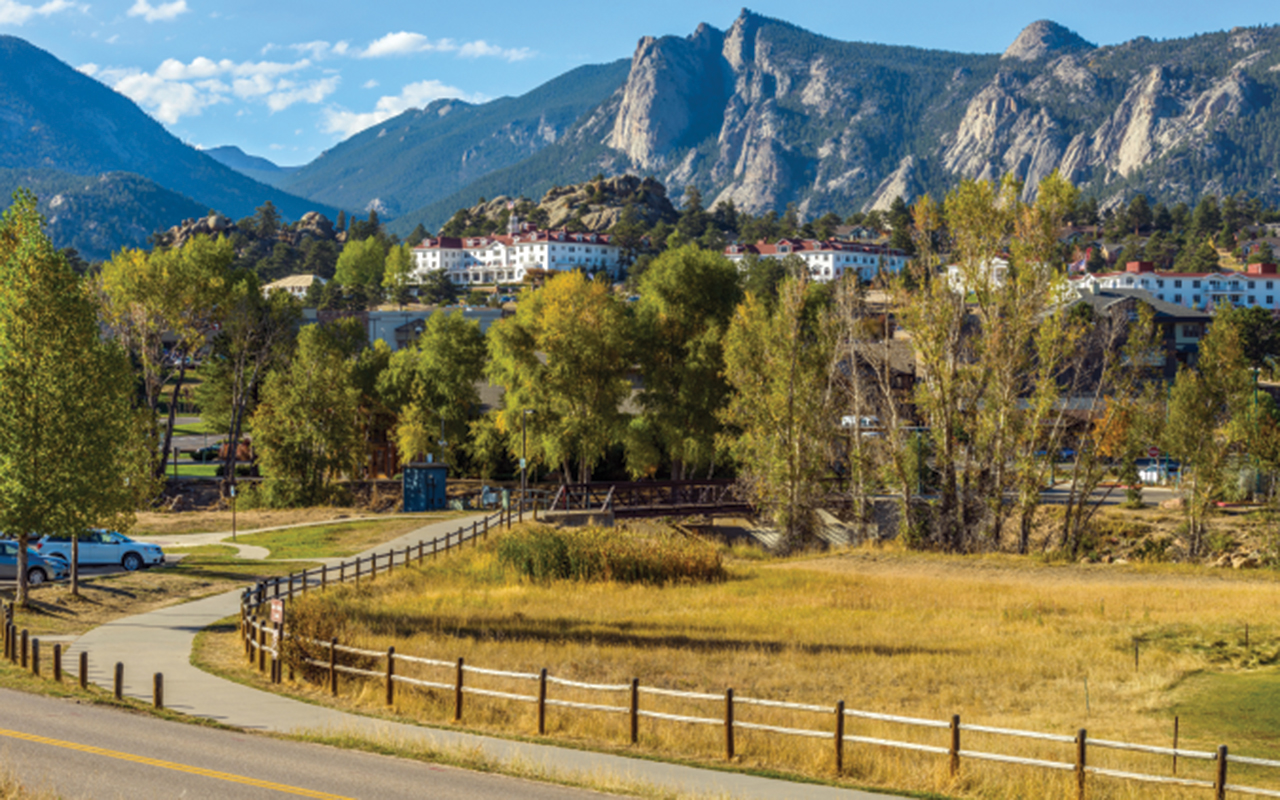
A night at the historic Stanley Hotel reportedly inspired author Stephen King to pen the horror novel, “The Shining.”
Today, the hotel is beautifully restored, complete with a gourmet restaurant and lavish spa. It’s not just historic, but also luxurious with amazing artwork and views of the valley and surrounding mountains.
Another unexpected bonus of our September stay in Estes Park was the annual visitation of dozens of elk. Nearly every day, they wandered through our campground, heading for town. They cross city streets, walk on the sidewalks and rest in city parks. It’s their mating season, aka “rut”, and the males, or bulls, are trying to impress the females by sparring, jarring their antlers against each other. Apparently, this has always been their winter range, as they were coming to the Estes Park area long before the town existed. City streets and buildings have not stopped them from continuing this annual rite of passage.
How long have the elk been following this ritual? It brings us back to F.O. Stanley again. By the early 1900s, hunters had virtually wiped out the elk population in the Estes valley. Stanley was helping to establish Rocky Mountain as a National Park at the time, and he recognized that the elk were a major tourist attraction. He arranged to transport a herd of Yellowstone elk from Montana to Estes Park utilizing his Stanley Steamers. Their descendants are the ones roaming the streets today.
As much as there is to do in Estes Park and on the park’s eastern boundary, the less populated western side of the park also offers some great recreational opportunities. With Rocky Mountain National Park as a breathtaking backdrop, the quaint town of Grand Lake sits on the largest and deepest natural body of water in the state, Grand Lake, located on the headwaters of the Colorado River. The lake borders on Shadow Mountain Lake and Lake Granby is just down the road.
Jay and Ginny Collier opted to stay in Grand lake, initially because it was on their travel route from their home in Prescott, Arizona. But after they started researching the area, they determined they’d be much happier and relaxed away from the crowds in Estes Park.
“We stayed at Elk Creek Campground and Resort,” says Ginny. “Most of our time there we visited the park. But there was so much to do in Grand Lake itself. The downtown area has been transformed into an old Western town with wooden sidewalks, saloons, breweries and some very cute shops.” The Colliers’ were there in September, so opted not to go swimming in the lake. “It was a bit cold for that,” says Ginny. They were mesmerized by the wildlife both in town and in the park. “There were moose walking around our campground,” Ginny continues. “When we entered the park, there were tons of elk everywhere. Because hardly anyone was around, we could pull over to the side of the road and the elk would just walk around our vehicle.”
The Colliers drove at least part of Trail Ridge Road every day they were there, including one trip all the way to Estes Park. “There were lots of really neat little hikes,” says Jay. “We hiked the Alpine Trail from the Alpine visitors center up to the very top of the pass — above 12,000 feet. We’ve visited a lot of national parks, but Rocky is one of our favorites.”
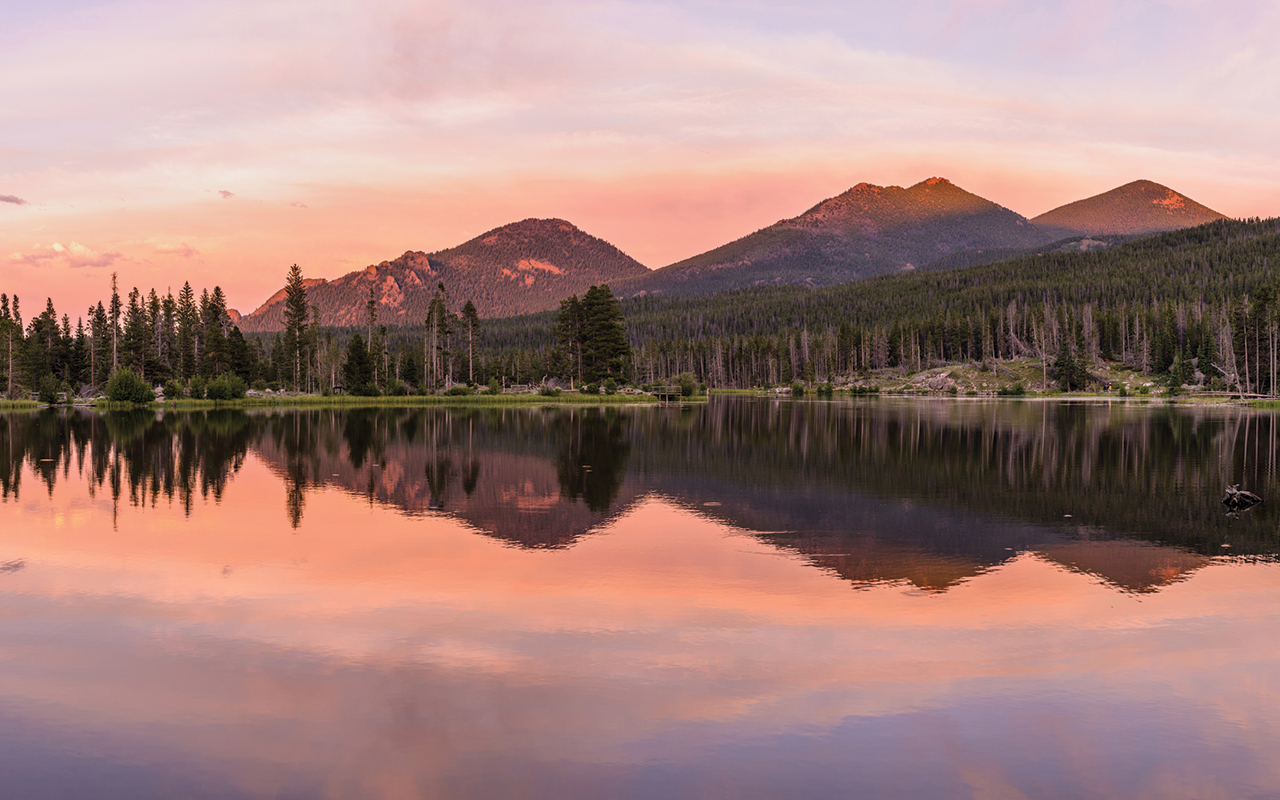
Boardwalks and bridges lead the way on the half-mile walk around Sprague Lake, with views of Flattop Mountain and Hallet Peak.
No matter what your preferences, from hiking an isolated mountain trail to watching wildlife to doing a Highland fling, Rocky and the surrounding areas have so much to offer.
The Great Divide
The Continental Divide of the Americas separates river systems that run toward the Pacific Ocean from those that run toward the Atlantic and Arctic oceans, and the Gulf of Mexico. The divide runs north-south through the park and marks a climatic division. According to www.nps.gov, what you see within short distances at Rocky is similar to the wider landscape changes seen on a drive from Denver to northern Alaska.

